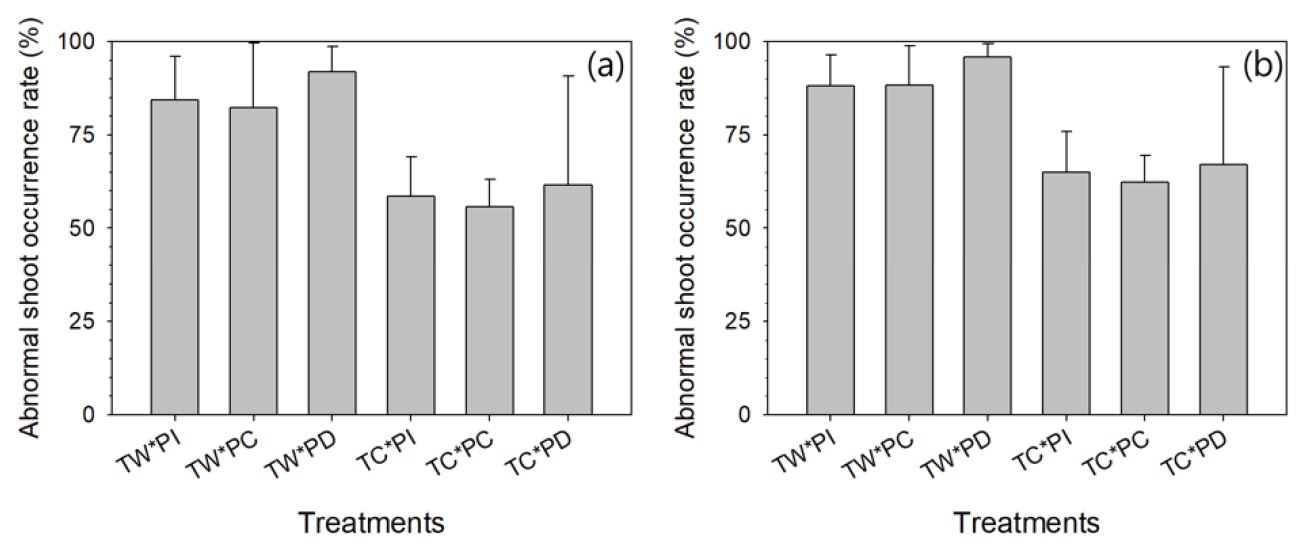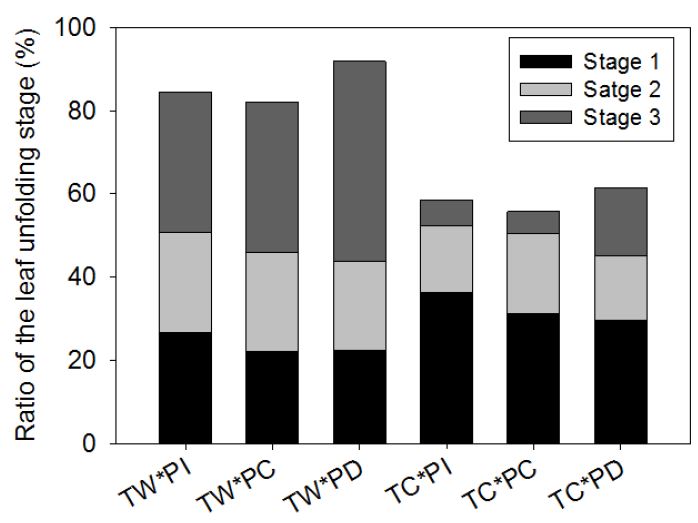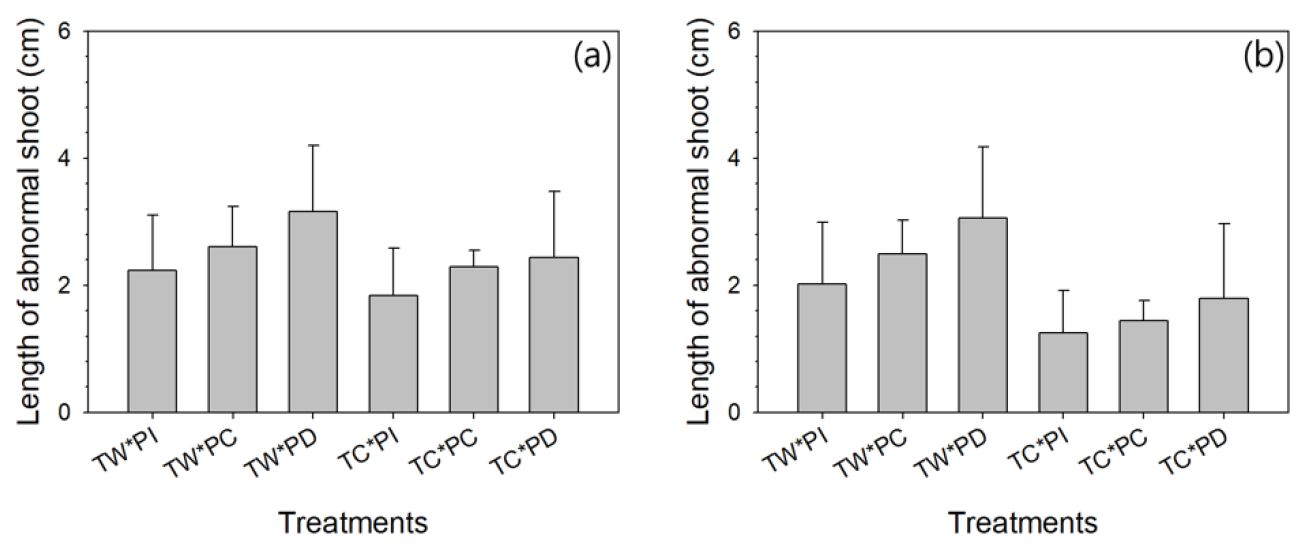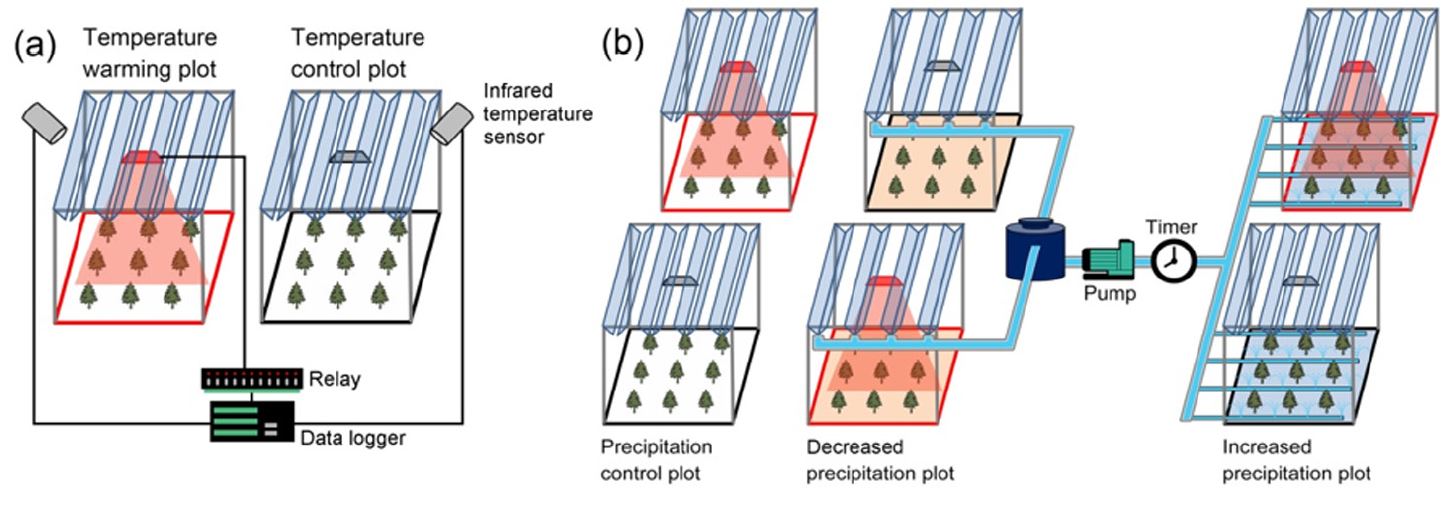
Abnormal Shoot Responses of Pinus densiflora Seedlings to Open-field Experimental Warming and Precipitation Manipulation
Abstract
This study was conducted to investigate abnormal shoot responses in Pinus densiflora seedlings to open-field warming and precipitation manipulation. In May 2017, 18 plots (2 temperature levels × 3 precipitation levels × 3 replicates) were constructed and 90 seedlings of 1-year-old P. densiflora were planted in each plot. The temperature in the temperature warming (TW) plots was set to 3°C higher than that in the temperature control (TC) plots, and precipitation was set to decrease (PD) or increase (PI) by 40% compared to the precipitation control (PC) plots. The manipulation experiment started in June, 2017. The abnormal shoot occurrence rates in September and November, 2017; seedling number in each needle length growth stage in September, 2017; and length of abnormal shoots in November, 2017 were measured. Warming significantly increased the occurrence rate and developed the needle length growth stage of abnormal shoots in P. densiflora seedlings, whereas precipitation and interaction effects between the two treatments were not significant. The mean occurrence rates in September and November were 86.17 ± 11.80% and 90.78 ± 7.92% in the TW plots and 58.59 ± 16.13% and 64.80 ± 14.71% in the TC plots, respectively. Thus, the abnormal conditions derived from increased temperature stimulated the occurrence of abnormal shoots. Warming also elongated the needle length of the abnormal shoots, which might affect future photosynthesis. However, there was no significant difference in abnormal shoot length under warming and precipitation manipulation. Thus, warming stimulated the occurrence and needle development of abnormal shoots in P. densiflora seedlings, which could lead to the inhibition of subsequent growth by the use of reserved nutrients and degradation of seedling quality.
Keywords:
Abnormal shoot, Climate change, Drought, High temperature, Japanese red pine1. Introduction
The Intergovernmental Panel on Climate Change (2014) have predicted future global climate change, including an increase in temperature and either an increase or decrease in precipitation. Climate change has already influenced the climate of the Korean Peninsula and additional temperature and precipitation changes have been predicted (Korea Global Atmosphere Watch Center, 2005; National Institute of Meteorological Science, 2018). Changes in temperature and precipitation severely influence plant phenology (Kramer et al., 2000; Chmielewski and Rötzer, 2001; Badeck et al., 2004), and changes in leaf senescence, unfolding, and leaf fall have been reported (Peñuelas and Filella, 2009; Estiarte and Peñuelas, 2015; Bigler and Bugmann, 2018). Changes in phenology may affect the growth, frost hardiness, foliage area, and photosynthetic capacity of plants (Kramer et al., 2000).
Usually, fixed growth species elongate their fixed shoot length once a year during spring (Kozlowski, 1964). After shoot growth has finished, trees store nutrients that are synthesized by photosynthesis from summer to autumn for growth in the next year (Cho, 2001; Lee, 2001). However, fixed growth species occasionally develop additional abnormal shoots that were not expected to occur until the next year after the annual shoot growth (Kramer and Kozlowski, 2012; Chang et al., 2018). Abnormal shoot formation can inhibit growth in the subsequent year because the nutrients that were supposed to be saved for the following year are used for additional growth (Cho, 2001; Nakashima and Yamamoto, 2006). In addition, abnormal shoots often cause winter injuries because late-formed shoots are not hardened enough by winter (Kozlowski, 1964; Kramer and Kozlowski, 2012), which might result in stem forking and poor stem formation that deviates from the one-axial scheme (Thomas, 1958; Kozlowski, 1964). These responses may reduce the seedling quality and viability of the trees (Schermann et al., 1977).
Similar to other phenological responses, abnormal shoots are affected by climate change (Chang et al., 2018). Increasing temperature has been reported to stimulate the production of abnormal shoots on trees by its own direct effect or by indirectly extending the growth period (Rudolph, 1964; Kushida, 2005; Lee et al., 2007; Chang et al., 2018). In addition, precipitation increases during the late-season might also cause abnormal shoot growth in response to available water abundance (Kozlowski, 1964; Kramer and Kozlowski, 2012). However, phenology and abnormal shoots are known to be more affected by temperature than by precipitation (Morin et al., 2010; Chang et al., 2018).
Pinus densiflora accounts for 27% of the forest area in Korea (Byun et al., 2010) and is recognized as one of the most important species because of its high-quality wood products, cultural value, and historical value (Song et al., 2012). P. densiflora is a fixed growth species, and thus is relatively vulnerable to climate change (Yun et al., 2016). By 2070, most of the P. densiflora forests are predicted to have been replaced owing to a decrease in their growth caused by climate change (Byun et al., 2010). Abnormal shoot responses could be one of the responses to climate change in P. densiflora that might affect subsequent growth and viability. Physiology or growth responses of P. densiflora under simulated climate change have been studied (Lee et al., 2013; Park et al., 2016; Yun et al., 2016; Han et al., 2018); however, there are limited studies on abnormal shoot responses (Chang et al., 2018). An experimental study approach on climate change has the advantage of identifying the actual responses to specific environmental factors (Kreyling and Beier, 2013). In particular, open-field experimental studies can simulate the actual climate change (Rustad et al., 2001).
Therefore, an open-field experimental warming and precipitation system was established to understand the responses of abnormal shoots in P. densiflora seedlings. The following hypothesis was presented in the present study: Warming and increasing precipitation will enhance the occurrence and stimulate the needle length growth and length of abnormal shoots.
2. Materials and Methods
2.1 Experimental design
An open-field nursery site was established in the Forest Technology and Management Research Center, Pocheon, central Korea (37°45'38.9'' N, 127°10'13.4'' E). Annual air temperature of the study site was 10.26°C and annual precipitation was 1112.0 mm in 2017 (Open Data Portal, 2018). 90 seedlings of 1-year-old P. densiflora were planted in plots sized 1 m × 1 m, based on the guidelines for seed and seedling management (Korea Forest Service, 2015) on May 18, 2017. P. densiflora grows continuously for one year after germination, and it shifts to fixed growth from the second year (Hirata et al., 2011). In this study, 1-year-old seedlings that have undergone continuous growth and have begun fixed growth were studied. The open-field experimental warming and precipitation manipulation started on June 28, 2017 after the seedlings had rooted. The experimental system was designed to create the forecasted environmental conditions of Pocheon in 2060, according to the Representative Concentration Pathways 8.5 climate change scenario (Korea Global Atmosphere Watch Center, 2005). Six treatments combining two temperature levels [temperature control (TC) and temperature warming (TW)] and three precipitation levels [precipitation control (PC), decreased precipitation (PD), and increased precipitation (PI)] were established with three replicates for each treatment.
In the TW plots, air temperature was set to 3°C higher than that in the TC plots. Infrared temperature sensors (SI-111, Campbell Scientific Inc., Logan, Utah, USA), data loggers (CR-1000, Campbell Scientific Inc.), and relays (SDM-CD16AC, Campbell Scientific Inc.) were used to control the infrared heaters (FTE-1000, Mor Electric Heating Association, Comstock Park, Michigan, USA) that were installed 60 cm above the seedling canopy in the TW plots to maintain the temperature difference between the TW and TC plots (Fig. 1a). In the PD plots, precipitation was decreased by covering 40% of the plot areas with transparent panels (Fig. 1b). The blocked precipitation was collected in a water tank and irrigated to the PI plots to increase the precipitation using a timer and irrigation system (Fig. 1b). Air temperature was 2.80°C higher in the TW plots than that in the TC plots, and soil water content was 6.56% lower in the PD plots and 25.36% higher in the PI plots than that in PC plots during the study period.
2.2 Abnormal shoot responses
The number of seedlings with abnormal shoots in each plot was measured in September and November, 2017 and the abnormal shoot occurrence rate was calculated as the number of seedlings representing the abnormal shoots per total seedlings. The stage in which the abnormal shoots did not occur was classified as stage 0 and the needle length growth of the lammas shoot was classified into three stages (stage 1: needles elongated by less than 2 cm; stage 2: needles elongated by 2 cm to 4 cm; and stage 3: needles elongated by 4 cm or more). In September, the degree of needle length growth for abnormal shoots was divided into four stages and the number of seedlings in each stage was observed (Fig. 2). The ratio of seedlings in each needle length growth stage per total seedlings was then calculated. The length from the start of the abnormal shoots to the end of the lammas shoot was measured in November, 2017. The average abnormal shoot length of the seedlings excluding seedlings without abnormal shoots and the average length of the seedlings including all the seedlings were then calculated.

Stages of needle length growth on abnormal shoot of Pinus densiflora seedlings. Closed bud (0); Needles elongated less than 2 cm (1); Needles elongated by 2 cm to 4 cm (2); Needles elongated by 4 cm or more (3).
Using the SAS 9.4 software program (SAS Institute Inc., USA), abnormal shoot occurrence rate, ratio of each stage, and length of abnormal shoots were analyzed by two-way analysis of variance (ANOVA) tests (n = 3). At p < 0.05, all results were considered statistically significant. Tukey’s test was used for post-hoc analysis.
3. Results and discussion
The abnormal shoot occurrence rate was significantly affected by warming in both September and November, 2017 (Table 1). The abnormal shoot occurrence rate was 58.59% ± 16.13% and 64.80 ± 14.71% in TC plots, and 86.17 ± 11.80% and 90.78 ± 7.92% in TW plots in September and November, respectively (Fig. 3). However, the effect of precipitation manipulation and the interaction between warming and precipitation manipulation were not significant in both months.

Results of two way analysis of variance (ANOVA) tests for abnormal shoot responses in Pinus densiflora seedlings

The mean abnormal shoot occurrence rate of Pinus densiflora seedlings in September (a) and November (b). TW: temperature warming, TC: temperature control, PI: increased precipitation, PC: precipitation control, PD: decreased precipitation.
Our results support our hypothesis that warming would increase the occurrence of abnormal shoots. Abnormal shoot responses are known to be caused by the extension of the seedling growth period and high temperatures under warming conditions (Chang et al., 2018). However, the beginning of the growth period in the present study could not be advanced by the warming because the system operation was established on June 28, 2017, when the growth period had already started. In addition, abnormal shoot occurrence in the seedlings in the TC plots was continuously observed until November, which was similar to that seen in the TW plots; thus, it appears that the growth period did not end during the study period. Therefore, abnormal shoot occurrence might have increased in response to the high temperature in the TW plots. Morin et al. (2010), Hossain and Teixeira Da Silva (2012), and Hossain et al. (2012) have shown that high temperature affects the phenology of seedlings. Thus, heat accumulation might cause an abnormal condition in P. densiflora, which might be close to the conditions required for the occurrence of abnormal shoots (Kozlowski, 1964; Byun et al., 2013). The occurrence of abnormal shoots increased with increasing temperatures, with seedlings then becoming damaged by frost, poor stem formation, and inhibition of growth in subsequent years, which might reduce seedling quality (Thomas, 1958; Kozlowski, 1964; Schermann et al., 1977; Nakashima and Yamamoto, 2006). Further studies on the effects of the growth period are required to fully understand the occurrence of abnormal shoots.
More detailed results were identified via the analysis of the needle length growth stage of abnormal shoots in September (Fig. 4). Warming significantly affected the number of seedlings in stages 1 (p = 0.0453), 2 (p = 0.0484), and 3 (p = 0.0002). In TW plots, stage 3 seedlings occupied the largest proportion (39.35%), followed by stages 1 (23.63%) and 2 (23.15%). In TC plots, stage 1 seedlings accounted for the largest proportion (32.38%), and stages 2 (16.94%) and 3 (9.27%) followed (Fig. 4). However, there were no significant differences in the ratio of seedling numbers during any of the stages in the precipitation manipulation; moreover, there was no interaction between warming and precipitation manipulation during any of the stages.

The ratio of each needle length growth stage observed on Pinus densiflora seedlings in September. Abbreviations of the treatments are as in Fig. 3.

The average length of abnormal shoots (a) and the average length of abnormal shoots including undeveloped shoots (b) in Pinus densiflora seedlings. Abbreviations of the treatments are as in Fig. 3.
Warming increased the number of seedlings with more advanced needle length growth stage. The mean needle length was relatively longer in TW plots than in TC plots. This might be caused by the advancement of the date of the leaf unfolding period and the increase in the needle length growth rate (Bigler and Bugmann, 2018). Different needle length growth rates cause differences in the photosynthetic leaf area, which can affect further metabolism, nutrient stage, and growth in P. densiflora (An et al., 2016).
Both warming and precipitation did not significantly affect the length of the abnormal shoots in P. densiflora seedlings. Additionally, the interaction between warming and precipitation did not significantly affect the length of the abnormal shoots (Table 1). This is consistent with previous studies where warming and precipitation changes did not affect the growth of P. densiflora, although warming did influence plant phenology (Chang et al., 2018). However, in the present study, when the average length of the abnormal shoots was calculated including the seedlings, which showed no abnormal shoots, the length was significantly affected by warming. In this case, the average length was 2.53 ± 0.91 cm in the TW plots and 1.50 ± 0.73 cm in the TC plots. Thus, even though there was no difference in the lengths of the abnormal shoots, it could be assumed that the overall tree height would be increased under warming because the occurrence rate of abnormal shoots increased (Park et al., 2016).
Results from the precipitation manipulation experiment did not support the hypothesis that a precipitation increase will increase the occurrence of abnormal shoots (Kramer and Kozlowski, 2012); precipitation manipulation did not affect the occurrence rate, needle length growth, and shoot length of abnormal shoots. Precipitation might have exceeded the amount of water required to cause abnormal shoots, and may not have had a significant effect on the occurrence of abnormal shoots because all plots had enough precipitation to generate abnormal shoots (Chang et al., 2018). Abnormal shoots are often formed when available water is abundant, with Mutke et al. (2003) reporting that abnormal shoots in inner Spain occurred when the summer monthly precipitation was greater than 30 mm. In our study, the mean monthly accumulative precipitation from June to August was 298.17 mm, which was enough to cause abnormal shoots in the PD plots that had 40% precipitation reduction treatment. Additionally, as in previous studies, the effects of warming were more obvious than the effects of precipitation variation (Morin et al., 2010; Chang et al., 2018).
4. Conclusion
Abnormal shoot responses in P. densiflora seedlings under open-field warming and precipitation manipulation were investigated in the present study. Abnormal shoot responses were only influenced by warming, resulting in an increase in the occurrence rate and needle length growth of abnormal shoots. Our findings indicated that warming increased the incidence of abnormal shoots, which may degrade the seedling quality and viability of P. densiflora by increasing frost damage, forming poor stems, and decreasing subsequent growth. However, the present study was only conducted for a short period of time, and the growth period and growth changes in the following year might cause additional abnormal shoot responses. Therefore, multi-year studies are required to fully understand the effects of climate change on abnormal shoots, which will help in understanding the effect of climate change on P. densiflora.
Acknowledgments
This research was carried out with the support of Korea Forest Service (2017058A00-1819-AB01).
References
- An, J, Han, SH, Chang, H, Park, MJ, Son, Y, (2016), Effects of experimental warming on physiological responses of four deciduous tree species seedlings Korea, Journal of Korean Forest Society, 105(4), p510-516, (in Korean with English abstract).
- Badeck, FW, Bondeau, A, Böttcher, K, Doktor, D, Lucht, W, Schaber, J, Sitch, S, (2004), Responses of spring phenology to climate change, New Phytologist, 162(2), p295-309.
-
Bigler, C, Bugmann, H, (2018), Climate-induced shifts in leaf unfolding and frost risk of European trees and shrubs, Scientific Reports, 8(1), p9865.
[https://doi.org/10.1038/s41598-018-27893-1]

- Byun, JG, Lee, WK, Nor, DK, Kim, SH, Choi, JK, Lee, YJ, (2010), The relationship between tree radial growth and topographic and climate factors in red pine and oak in central regions of Korea, Journal of Korean Forest Society, 99(6), p908-913, (in Korean with English abstract).
-
Byun, JG, Lee, WK, Kim, M, Kwak, DA, Kwak, H, Park, T, Byun, WH, Son, YH, Choi, JK, Lee, YJ, Saborowski, J, Chung, DJ, Jung, JH, (2013), Radial growth response of Pinus densiflora and Quercus spp. to topographic and climatic factors in South Korea, Journal of Plant Ecology, 6(5), p380-392.
[https://doi.org/10.1093/jpe/rtt001]

-
Chang, H, Han, SH, An, J, Park, MJ, Son, Y, (2018), Warming results in advanced spring phenology, delayed leaf fall, and developed abnormal shoots in Pinus densiflora seedlings, Trees, 32(5), p1473-1479.
[https://doi.org/10.1007/s00468-018-1709-9]

-
Chmielewski, FM, Rötzer, T, (2001), Response of tree phenology to climate change across Europe, Agricultural and Forest Meteorology, 108(2), p101-112.
[https://doi.org/10.1016/s0168-1923(01)00233-7]

- Cho, H, Hong, S, Kim, J, (2001), Studies on growth and biomass production of Abies koreana seedlings under different relative light intensity, Journal of Korea Forestry Energy, 20(2), p58-68, (in Korean with English abstract).
-
Estiarte, M, Peñuelas, J, (2015), Alteration of the phenology of leaf senescence and fall in winter deciduous species by climate change: effects on nutrient proficiency, Global Change Biology, 21(3), p1005-1017.
[https://doi.org/10.1111/gcb.12804]

- Han, SH, Chang, H, Son, Y, (2018), Short-term effects of warming and precipitation manipulation on seasonal changes in fine root production and mortality for Pinus densiflora seedlings, Journal of Korean Society of Forest Science, 107(1), p43-49, (in Korean with English abstract).
-
Hirata, M, Yamamoto, M, Aoki, M, Nakashima, A, (2011), Effect of heating in autumn on growth of Pinus densiflora SIEB.et ZUCC from different habitats in small area, Journal of the Japanese Society of Revegetation Technology, 37(1), p32-37, (in Japanese with English abstract).
[https://doi.org/10.7211/jjsrt.37.32]

-
Hossain, A, Teixeira Da Silva, JA, (2012), Phenology, growth and yield of three wheat (Triticum aestivum L.) varieties as affected by high temperature stress, Notulae Scientia Biologicae, 4(3), p97-109.
[https://doi.org/10.15835/nsb437879]

-
Hossain, A, Teixeira Da Silva, JA, Lozovskaya, MV, Zvolinsky, VP, (2012), High temperature combined with drought affect rainfed spring wheat and barley in South-Eastern Russia: I. Phenology and growth, Saudi Journal of Biological Sciences, 19(4), p473-487.
[https://doi.org/10.1016/j.sjbs.2012.07.005]

- Intergovernmental Panel on Climate Change (IPCC), (2014), Climate change 2014: synthesis report, UK, Contribution of Working Groups I, II and III to the Fifth Assessment Report of the Intergovernmental Panel on Climate Change.
- Korea Forest Service, (2015), Guidelines for seed and seedling management, Korea, Korea Forest Service (in Korean).
- Korea Global Atmosphere Watch Center, (2005), RCP Korean peninsula scenario, Korea, Korea Global Atmosphere Watch Center.
-
Kozlowski, TT, (1964), Shoot growth in woody plants, The Botanical Review, 30(3), p335-392.
[https://doi.org/10.1007/bf02858538]

-
Kramer, K, Leinonen, I, Loustau, D, (2000), The importance of phenology for the evaluation of impact of climate change on growth of boreal, temperate and Mediterranean forests ecosystems: an overview, International Journal of Biometeorology, 44(2), p67-75.
[https://doi.org/10.1007/s004840000066]

- Kramer, PJ, Kozlowski, TT, (2012), Physiology of woody plants, USA, Academic Press.
-
Kreyling, J, Beier, C, (2013), Complexity in climate change manipulation experiments, Bioscience, 63(9), p763-767.
[https://doi.org/10.1093/bioscience/63.9.763]

- Kushida, T, (2005), Effect of high summer temperatures on lammas shoot elongation and flowering in Japanese red pine, Phyton, 45(4), p215-221.
-
Lee, C, Song, H., Kim, H, Lee, B, Pi, J, Cho, Y, Seol, E, Oh, W, Park, S, Lee, S, (2007), Which environmental factors caused lammas shoot growth of Korean red pine?, Journal of Ecology and Environment, 30(1), p101-105.
[https://doi.org/10.5141/jefb.2007.30.1.101]

- Lee, KJ, (2011), Tree physiology, 3rd edition, Korea, Seoul University Press.
-
Morin, X, Roy, J, Sonié, L, Chuine, I, (2010), Changes in leaf phenology of three European oak species in response to experimental climate change, New Phytologist, 186(4), p900-910.
[https://doi.org/10.1111/j.1469-8137.2010.03252.x]

-
Mutke, S, Gordo, J, Climent, J, Gil, L, (2003), Shoot growth and phenology modelling of grafted stone pine (Pinus pinea L.) in inner Spain, Annals of Forest Science, 60(6), p527-537.
[https://doi.org/10.1051/forest:2003046]

-
Nakashima, A, Yamamoto, M, (2006), Effects of year-round warming on the growth of Pinus densiflora SIEB. et ZUCC, Journal of the Japanese Society of Revegetation Technology, 32(1), p127-130, (in Japanese with English abstract).
[https://doi.org/10.7211/jjsrt.32.127]

- National Institute of Meteorological Science, (2018), Climate change in 100 years of Korean peninsula, [accessed 2018 November 30]. http://www.nimr.go.kr/?sub_num=755&state=view&idx=4168.
- Open Data Portal, (2018), Automatic weather station (AWS) Hourly observations, [accessed 2018 March 29]. https://www.data.go.kr/dataset/15025428/openapi.do.
-
Park, MJ, Yun, SJ, Yun, HM, Chang, H, Han, SH, An, J, Son, Y, (2016), Effects of open-field artificial warming and precipitation manipulation on physiological characteristics and growth of Pinus densiflora seedlings, Journal of Climate Change Research, 7(1), p9-17, (in Korean with English abstract).
[https://doi.org/10.15531/ksccr.2016.7.1.9]

- Peñuelas, J, Filella, I, (2009), Phenology feedbacks on climate change, Science, 324(5929), p887-888.
-
Rudolph, TD, (1964), Lammas growth and prolepsis in jack pine in the Lake States, Forest Science, 10(suppl_1), pa0001-70.
[https://doi.org/10.1093/forestscience/10.s1.a0001]

- Rustad, LE, Campbell, JL, Marion, GM, Norby, RJ, Mitchell, MJ, Hartley, AE, Cornelissen, JHC, Gurevitch, J, GCTE-NEWS, (2001), A meta-analysis of the response of soil respiration, net nitrogen mineralization, and aboveground plant growth to experimental ecosystem warming, Oecologia, 126(4), p543-562.
- Schermann, N, Adams, WT, Aitken, SN, Bastien, JC, (1997), Genetic parameters of stem form traits in a 9-year-old coastal Douglas-fir progeny test in Washington, Silvae Genetica, 46(2), p166-169.
-
Song, H, Kim, C, Moon, M, Kim, M, (2012), A change and distribution in Pinus densiflora forest of Mt. Hallasan, Journal of the Environmental Sciences, 21(1), p41-47.
[https://doi.org/10.5322/jes.2012.21.1.41]

-
Thomas, JB, (1958), The production of lammas shoots on jack pine in Ontario, The Forestry Chronicle, 34(3), p307-309.
[https://doi.org/10.5558/tfc34307-3]

-
Yun, SJ, Han, S, Han, SH, Kim, S, Li, G, Park, M, Son, Y, (2016), Short-term effects of warming treatment and precipitation manipulation on the ecophysiological responses of Pinus densiflora seedlings, Turkish Journal of Agriculture and Forestry, 40(4), p621-630.
[https://doi.org/10.3906/tar-1511-68]


